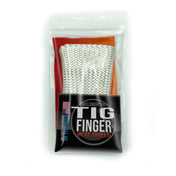This video shows Techniques for Limiting Distortion and Avoiding Cracks
The backstep technique is when you weld a short section and then back up behind that weld and make another short weld that blends into the previous short weld.
Back stepping can help limit distortion.
On an aerospace test weld on really thin metal, the back step technique can really help.
For example, if the test piece is 15-7ph stainless steel and only .020" thick, welding a full 6 inches without stopping can cause excessive distortion or deflection.
Welding a 5 or 6 inch long test piece might not seem like much but depending on the fixture provided, a full length run might not be the best approach.
3 shorter welds can be more efficient.
But then you have more tie ins where defects tend to happen.
I have found that tapering amperage while continuing to travel prevents cracks and crater holes.
This video demonstrates the backstep technique as well as the amperage tapering technique on .040" thick steel using ER312L filler metal. I am also using a PrimeWeld TIG 225x TIG Machine. We include a basic stubby kit with every 225x sold at Weldmonger.com so be sure to check it out.








2 comments
Thank you for all your great educational videos. As a self taught welder you have been a huge help and an inspiriting artist at the craft. Wow, we are so lucky to have you a as resource!
what do you use on cast iron? Your videos are Awesome and I fined much of it very use full.
Thank you.
Larry